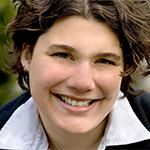The Faculty of Medicine is transforming teaching and assessment with a variety of innovations to help enrich and accelerate how medical students learn.
“Medical education is often compared to drinking from a fire hose, so anything we can do to help our students learn more effectively, we are willing to try,” says David Snadden, the faculty’s executive associate dean of education.
Nervous about neurons: multimedia fix
It’s called neurophobia, it affects hundreds at UBC, and Dr. Claudia Krebs just might have found the cure.
Krebs, a senior instructor in the Dept. of Cellular and Physiological Sciences, uses the term “neurophobia” to describe her students’ fear of being unable to comprehend the brain’s complexities. The fix, she has discovered, is a flexible approach to learning.
In her revamped Brain and Behaviours Lab, first offered in January 2014, Krebs takes advantage of the dynamism and eye-candy appeal of digital graphics and the flexibility of video lectures.
Rather than use weekly lab sessions for lectures and note-taking, students view video lectures in advance, and take in information at their own pace. Class time is then dedicated to applying new knowledge through problem-solving and hands-on work with donated brains and spinal cords and to real clinical cases.

Dr. Claudia Krebs
For each lab, Krebs and her team created a set of online slides, many of which incorporate anatomical watercolours from the 1950s created by Nan Cheney, the Faculty of Medicine’s first medical illustrator. With a click, a picture appears with an explanatory block of text, followed by pop-ups pointing to various parts of the brain and spinal cord. Practice slides ask students to drag and drop labels to various brain parts, or to answer multiple-choice questions.
The results of this innovative approach are impressive. Student surveys conducted at the end of the term showed 32 per cent are now likely or very likely to consider a residency in neurology, psychiatry or related field—a huge increase from previous years, says Krebs. Students also did significantly better on exams. Feedback about workload—flagged as a problem by two-thirds of respondents—will be addressed in time for the next rollout in January 2015.
“It’s hugely satisfying to think our work may open new doors for students,” says Krebs. “Now they feel better prepared to pursue neuro-related fields.”
Distant heartbeats: introducing the tele-stethoscope
An electronic stethoscope now allows medical students to hear heartbeats from miles away.
Neurologist John Falconer, a clinical assistant professor in the Dept. of Medicine, has been introducing students to the tele-stethoscope, a device that wirelessly connects stethoscope and patient.
When a nurse or medical student puts the tele-stethoscope on a patient’s chest, heart and lung sounds can be heard and interpreted by a specialist in a distant locale, through a remote connection. This allows for immediate diagnosis without patients needing to travel to larger centres to see a specialist.
Patients get faster access to the care they need and avoid the costs and time required to see a specialist. The health-care system benefits by providing needed care without costs and delays involved in getting specialists to smaller towns.
Anatomy Apps: multiple viewpoints
Dissections have gone digital for medical students at UBC’s Okanagan campus, who are using iPads to augment anatomy classes.
Dr. Olusegun Oyedele, anatomy instructor in the Southern Medical Program, has students using digital tablets to compare diagrams, MRIs and videos with real specimens in the lab.
“Anatomy is very visual, very three-dimensional–you need to examine structures from multiple points of view,” he explains. “Technology allows us to employ all those different perspectives in teaching our students.”
Educational research shows that learning is more effective when it employs multiple approaches, he adds.
As for students, they say being able to consolidate medical textbook knowledge with 3-D material helps prepare them to make clinical diagnoses as practicing physicians.
Tele-mental health: psychiatry from a distance
A pilot project that teams telehealth technology with carefully scripted theatre aims to help third-year medical students build skills in conducting complex and intense psychiatric interviews.
Called Remote Human Interactions for Tele-Health Mentorship (RHITHM), the project is led by psychiatrists Dr. Neil Hanon, a UBC medical rotation leader at Kelowna General Hospital, and Dr. Kendall Ho, director of the Faculty of Medicine’s eHealth Strategy Office.
For the first time, students will interact with standardized patients – actors playing patient roles – using distance technology. Formerly, students learned by interviewing actual patients in hospital, but had no opportunity for feedback directly and frankly from the patients on their skills. This training gives them just that.
“This new approach asks ‘patients’ for details about how the interview felt for them,” explains Hanon. “That input, combined with reviewing the videos, gives both the instructor and the student so much more to work with.”
Students complete two interviews screen-to-screen: one with an instructor and peers observing, and a second without supervision. Because they are literally unable to reach out to patients, students must focus on expressing empathy through words and body language. Recordings from both sessions are used for evaluation and feedback to the group, and provide a level of detail not previously possible.
“If we can teach students how to use telehealth to interact with patients, it will be incredibly useful for them in their future practice,” says Hanon.
The pilot project could have applications beyond medical training, as telehealth consultations could help link remote B.C. communities to psychiatric specialists across long distances.